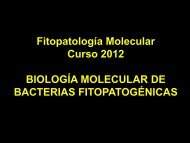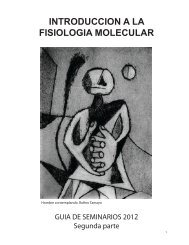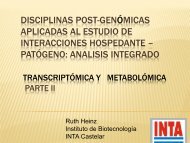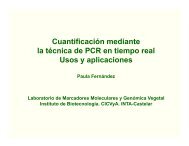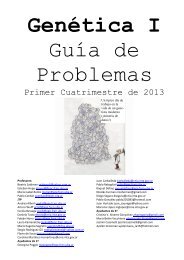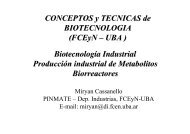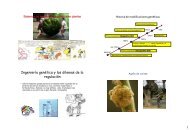Reacción en cadena de la polimerasa (PCR) - FBMC
Reacción en cadena de la polimerasa (PCR) - FBMC
Reacción en cadena de la polimerasa (PCR) - FBMC
Create successful ePaper yourself
Turn your PDF publications into a flip-book with our unique Google optimized e-Paper software.
vas pérdidas <strong>de</strong> ADN (RD1- 14).<br />
El orig<strong>en</strong> <strong>de</strong> M. tuberculosis es muy antiguo. Se cree<br />
que <strong>la</strong>s bacterias <strong>de</strong>l género Mycobacterium, como otros<br />
actinomicetes, <strong>de</strong>rivan <strong>de</strong> un ancestro común <strong>de</strong> vida<br />
libre que se <strong>en</strong>contraba <strong>en</strong> el suelo y <strong>en</strong> el agua. Posiblem<strong>en</strong>te<br />
durante <strong>la</strong> especiación, los miembros <strong>de</strong>l complejo<br />
sufrieron un cuello <strong>de</strong> botel<strong>la</strong>, ocurrido hace 15000-20000<br />
años atrás (Sreevatsan, et al. 1997). Con <strong>la</strong>s secu<strong>en</strong>ciación<br />
<strong>de</strong> g<strong>en</strong>omas y <strong>la</strong> g<strong>en</strong>ómica comparativa se ind<strong>en</strong>tificaron<br />
regiones variables <strong>en</strong>tre los miembros <strong>de</strong>l MTC.<br />
Brosch y co<strong>la</strong>boradores, analizando 20 regiones <strong>de</strong> difer<strong>en</strong>cia<br />
(d<strong>en</strong>ominadas RD seguidas <strong>de</strong> un número) <strong>en</strong><br />
más <strong>de</strong> 100 cepas, id<strong>en</strong>tificaron <strong>de</strong>lecciones <strong>en</strong> el g<strong>en</strong>oma<br />
<strong>de</strong> M. bovis con respecto a M. tuberculosis lo que<br />
indica que el g<strong>en</strong>oma <strong>de</strong> este último es mayor (Brosch, et<br />
al. 2002). Encontraron evid<strong>en</strong>cias <strong>de</strong> que <strong>la</strong> <strong>de</strong>lección <strong>de</strong> ciertas regiones g<strong>en</strong>ómicas variables no ocurrió <strong>de</strong> manera<br />
in<strong>de</strong>p<strong>en</strong>di<strong>en</strong>te <strong>en</strong> <strong>la</strong>s difer<strong>en</strong>tes cepas <strong>de</strong>l complejo, lo que les permitió p<strong>la</strong>ntear un nuevo esc<strong>en</strong>ario para <strong>la</strong> evolución<br />
<strong>de</strong>l complejo M. tuberculosis y el orig<strong>en</strong> <strong>de</strong> <strong>la</strong> TB humana (Figura 1). Parecería que M. bovis (RD4, RD5,<br />
RD7, RD8, RD9, RD10, RD12, RD13) es el último repres<strong>en</strong>tante <strong>de</strong> un linaje junto con M. africanum (RD9) y<br />
M. microti (RD7, RD8, RD9, RD10) que <strong>de</strong>rivó <strong>de</strong>l prog<strong>en</strong>itor <strong>de</strong> M. tuberculosis antes <strong>de</strong> que ocurriera una <strong>de</strong>lección<br />
específica <strong>de</strong> tuberculosis TbD1 (Brosch, et al. 1999; 2002).<br />
OBJETIVOS:<br />
1) Id<strong>en</strong>tificar <strong>la</strong>s regiones g<strong>en</strong>ómicas <strong>de</strong> difer<strong>en</strong>cia <strong>en</strong>tre M. tuberculosis y M. bovis.<br />
2) Comparar los transcriptomas <strong>de</strong> ambas especies M. tuberculosis–M. bovis microarrays. Los microarreglos que se<br />
emplearán fueron provistos por el Dr Glyn Hewinson <strong>en</strong> el Veterinary Laboratories Ag<strong>en</strong>cy (Weybridge, UK). Los<br />
mismos fueron diseñados originalm<strong>en</strong>te por el Bacterial Microarray Group (BuG@S, St George‟s Hospital Medical<br />
School, Londres, UK). El microarreglo consiste <strong>de</strong> 4410 productos <strong>de</strong> <strong>PCR</strong> (rango <strong>de</strong> tamaño 60–1000 bp) que repres<strong>en</strong>tan<br />
todos los g<strong>en</strong>es <strong>de</strong> los g<strong>en</strong>omas <strong>de</strong> <strong>la</strong>s cepas H37Rv y CDC1551 <strong>de</strong> M. tuberculosis y <strong>la</strong> cepa AF2122<br />
<strong>de</strong> M. bovis<br />
MICROARRAY HYBRIDISATION PROTOCOL<br />
Use the following Cy-dye <strong>la</strong>belled dCTP volumes for the<br />
appropriate application:<br />
G<strong>en</strong>omic DNA <strong>la</strong>belling<br />
For each reaction:<br />
2-5μg g<strong>en</strong>omic DNA<br />
1μl Random primers<br />
to 41.5μl ddH2O<br />
95˚C for 5min, snap cool on<br />
ice and briefly c<strong>en</strong>trifuge.<br />
Th<strong>en</strong> add:<br />
5μl Kl<strong>en</strong>ow Buffer (10x)<br />
1μl dNTPs (5mM each dA/G/TTP, 2mM dCTP)<br />
1.5μl Cy3-dCTP<br />
1μl Kl<strong>en</strong>ow fragm<strong>en</strong>t (5U/μl)<br />
37˚C for 90min in the dark.<br />
cDNA synthesis and <strong>la</strong>belling<br />
For each sample:<br />
5-10μg RNA<br />
1.7μl Random primers<br />
to 15.9μl RNase-free H2O<br />
70˚C for 10min, snap cool on ice, spin down.<br />
Th<strong>en</strong> add (make a master mix for multiple <strong>la</strong>bellings):<br />
6μl 5x First StrandBuffer<br />
3μl 100mM DTT<br />
0.6μl dNTPs (25mM each dA/G/TTP, 10mM<br />
dCTP)<br />
2μl SuperScript II<br />
2.5μl Cy5-dCTP<br />
25˚C for 10 min in the dark.<br />
42˚C for 110min in the dark.<br />
Pre-hybridisation<br />
Mix the prehybridisation solution in a coplin jar and incubate<br />
at 65˚C during the <strong>la</strong>belling reaction to equilibrate.<br />
Solution Prehybridisation<br />
20x SSC 8.75ml (3.5x SSC)<br />
20% SDS 250μl (0.1% SDS)<br />
BSA (100mg/ml) 5ml (10mg/ml)<br />
ddH2O to 50ml<br />
Incubate the microarray sli<strong>de</strong> in the pre-heated prehybridisation<br />
solution for 20min<br />
Wash in 400ml ddH2O for 1min<br />
Wash in 400ml isopropanol for 1min<br />
Dry by spinning in 50ml c<strong>en</strong>trifuge tube at 1500rpm for<br />
5min<br />
Store sli<strong>de</strong> in the dark, dust-free box until hybridisation<br />
(



